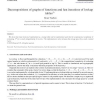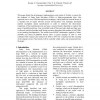1279 search results - page 32 / 256 » Fast Implementations of Automata Computations |
FAC
2008
13 years 7 months ago
2008
Abstract. Slicing is a program analysis technique that was originally introduced to improve program debugging and understanding. The purpose of a slicing algorithm is to remove the...
DAM
2007
13 years 7 months ago
2007
We show that every function f implemented as a lookup table can be implemented such that the computational complexity of evaluating f m(x) is small, independently of m and x. The ...
SASO
2008
IEEE
14 years 2 months ago
2008
IEEE
—When programming a spatial computing medium such as a cellular automaton, the hop count distance to some set of sources (particles) is an often used information. In particular, ...
DAC
2003
ACM
14 years 8 months ago
2003
ACM
Reseeding is used to improve fault coverage of pseudorandom testing. The seed corresponds to the initial state of the PRPG before filling the scan chain. In this paper, we present...
FPL
1999
Springer
13 years 12 months ago
1999
Springer
This paper details the development, implementation, and results of Synthia, a system for the synthesis of Finite State Machines (FSMs) to field-programmable logic. Our approach us...


